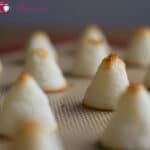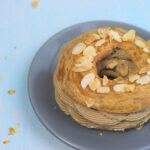I’ve seen Christophe Felder’s flan mentioned several times on blogs as being “the best flan” of all time. So I decided to try it out for my first entremet recipe!
I don’t know about you, but for me, flan is a fairly universal recipe. Whereas with chocolate recipes, you can quickly fall out with those who think it’s “too much” (sweet, heavy, nauseating…), with a flan opinions are generally unanimous and I’ve never heard anyone say to me: “sorry, I don’t like flan”.
I usually use the recipe from the “Livre du pâtissier”. A simple pastry cream on a puff pastry base. I particularly like this pastry cream recipe because it uses whole eggs, so you don’t end up with egg whites running out. This may seem like a trivial consideration, but when you’re cooking a lot, you soon find yourself throwing away leftovers or restarting a recipe to use up leftovers, leftovers, leftovers… (true story).
EDIT This is actually a simplification of Christophe Felder’s original recipe (see comments), I’ll test the real recipe soon to give an objective opinion.
The special features of Christophe Felder‘s flan
With Felder’s recipe, you don’t have to worry about eggs either, and you don’t have to worry about flan’s biggest technical problem: the puff pastry. Felder uses a rather sweet shortcrust pastry. As for the filling, the custard is thickened with heavy cream, making the flan quite compact. Although the recipe is simpler to make, you still need to plan ahead, as you’ll need to let the pastry cool down before using it in the tin.
You also need to let the pastry cream cool. To be on the safe side, I’d say you need to allow a good 2 hours (or even the day before) to avoid any unpleasant surprises. And if you’re REALLY motivated (and organized, which isn’t my case as I often cook on the spur of the moment), you can leave the vanilla pod to infuse in the boiled milk overnight, which will give it a stronger flavor.
Points to pay attention to
The most important points in this recipe are not to overwork the shortcrust pastry. Leave it to cool in the fridge so that it doesn’t shrink when baked. I find that tart dough is always a delicate preparation. You have to work it hard enough so that it amalgamates (and never, ever add water!), but not too hard either, so that it doesn’t develop too much gluten and become elastic…
Basically, as soon as it holds together, we roll it into a thick patty and leave it to cool in the fridge. After half an hour, let it come back to room temperature for 10 minutes (it’s brittle and difficult to work with otherwise), then roll it out without struggling. To stack the odds in your favor, I recommend using T55 flour, which is less rich in gluten. It’s not essential, but it does help to make the dough less elastic, especially when you’re not used to it (hum… even with a CAP , you often look at your oven with apprehension…).
For the crème pâtissière, make sure you always mix the egg/sugar/starch mixture well when you pour the boiling milk over it. Otherwise, the eggs will coagulate and you’re in trouble! I’ve given you a step-by-step guide in this recipe for chocolate custard. If your mixer isn’t a racehorse, sift the cornflour to avoid lumps once the milk is back on the heat. Then whisk gently over low heat until the mixture thickens to the consistency of mayonnaise.
Blank assembly
Leave the resulting crème pâtissière to cool. Once cold, give it a quick whirl with the mixer to make it more supple. That’s how you get a smooth surface, and then spread it over the tart base. Beware, cream thickens quite a bit when baked, so I recommend filling your tart base only 2/3 full. A final word of advice: the original recipe is for 16 people, so you can easily halve the number for a family dessert (for my part, I managed to fill a 22 cm high circle and a 20 cm one).
The verdict? This is definitely a very good recipe. The best I’ve ever eaten? Clearly not (but having lived next door to the bakery with the best recipe in Paris, my opinion may be a little biased). I found the pastry a little too sweet and that it lacked a little vanilla, despite my very good vanilla-infused milk. But the whole thing was still a very good dessert and my guests (more of a flan fan than me) really enjoyed it.
But having also heard a lot of good things about Conticini’s recipe, I’m thinking of organising a little battle soon!

Flan de Christophe Felder
Ingredients
Pour la pâte
- 125 g beurre pommade
- 125 g de sucre en poudre
- 250 g de farine type 55
- 1 œuf
- 1 pincée de levure chimique
Pour la crème
- 6 œufs
- 300 g de sucre en poudre
- 120 g de fécule de maïs (tamisée)
- 30 cL de crème liquide entière
- 1,2 L lait entier
- 2 cuillère à soupe de vanille liquide
Instructions
Pour la pâte
- Mélanger le beurre pommade et le sucre en poudre. Quand le mélange est bien amalgamé, ajouter la farine, la levure chimique et terminer par l’œuf.
- Pétrir jusqu'à ce que la pâte s'amalgame. Une fois la pâte homogène, faire une galette épaisse, la filmer et la laisser reposer une bonne demi-heure au frigo.
Pour la crème
- Mettre le lait à bouillir avec la moitié du sucre à feu doux
- Fouetter les œufs et le reste du sucre (sans blanchir).
- Ajouter la maïzena, la crème liquide et l'extrait de vanille.
- Quand le lait boue, le verser sur le mélange oeufs/sucre tout en continuant de fouetter.
- Remettre le mélange sur feu doux et remuer au fouet continuellement jusqu'à épaississement.
- Verser dans un plat et laisser refroidir 1 bonne heure.
Montage
- Sortir la pâte brisée et la laisser revenir à température ambiante 10 minutes. L'étaler sur 2-3 mm d'épaisseur et foncer un cercle à gâteau haut (au moins 4,5 cm). J'ai remis ma pâte au frais 20 minutes mais Felder ne le dit pas.
- Fouetter la crème pâtissière refroidie pour lui redonner de la souplesse et la verser sur le fond de tarte. Bien lisser pour obtenir une surface plane.
- Cuire 40 minutes à 180°C.
Notes
Nutrition
What is flan pâtissier?
Flan pâtissier is a traditional French pastry made with a crisp pastry (often shortcrust or puff pastry) and a mixture of milk, eggs and sugar. Its mild taste and creamy texture make it a popular dessert.
What is the origin of flan pâtissier?
Flan originated in France and England in the Middle Ages. In France, it has become popular in its current form over the centuries, and has become a bakery classic.
What’s the difference between a flan and a crème pâtissière?
Flan and crème pâtissière have similar bases, but the main difference lies in the cooking process:
The flan is baked in the oven, giving it a firm, melting texture.
Crème pâtissière is cooked in a pan and used to garnish choux pastries, éclairs and tarts.
How to make a successful homemade custard flan?
Here are a few tips for a perfect flan:
Use whole milk: for a creamy texture.
Do not overcook the appliance: it should remain slightly quivering in the center when removed from the oven.
Let stand: a good flan is best enjoyed cold, after several hours’ rest.
Variations on custard flan
Vanilla flan: The most classic version, with an infusion of vanilla beans for an intense fragrance.
Chocolate flan: Add cocoa powder or melted chocolate to the mixture for a gourmet version.
Flan sans pâte: A light, quick-to-prepare alternative.
What to serve flan pâtissier with?
Flan can be enjoyed on its own, but it also goes very well with :
Coffee or tea for a gourmet snack.
A caramel beurre salé sauce for even more flavour.
How to store a custard tart?
The flan will keep for up to 3 days in the refrigerator, well wrapped to prevent drying out.


